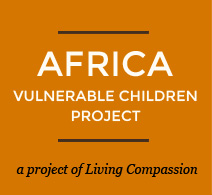Over time we have noticed that it takes a person’s body about three days to recover from the twelve-thousand-mile journey to Ndola. This is particularly the case with my stomach, it seems, which even now, after more than forty-eight hours if Africa, appears to be lost somewhere over the Pacific Ocean. Last night, as I lay awake, jet-lagged, through the wee hours as usual, I soaked up the African sounds and smells that came in through the windows of my room: the calls of strange nighttime birds, the people shouting in the distance in Bemba, the smoke that is always in the air…. It is good to be here, I thought to myself, in this place that has become a second home to me.
Friday picked me up first thing in the morning. Readers of previous blogs will remember him well, I’m sure. Our relationship with Friday began when he rescued us after our car broke down summer before last. He quickly became our mechanic, and then our friend. In July, impressed by his hard work and willingness, we hired him to oversee some of our projects in Kantolomba. We look forward to a long and fruitful relationship with this most gentle man.
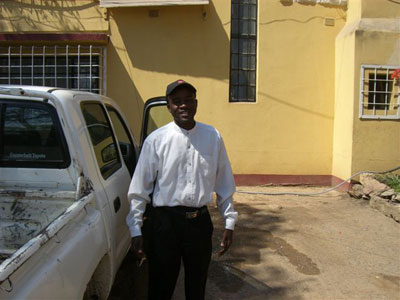
Friday
It was wonderful to see him. I have a special place in my heart for Friday after all the hours we spent together over the hopeless task of resurrecting our Land Cruiser. He greeted me in the nonchalant way he has, as if we had just seen each other yesterday. Friday is more a man of action than a man of words, which suits me fine. After our simple hellos we jumped in his truck and headed out upon our day’s adventure.
I was eager to see Kantolomba again after a six-month absence. We drove in the back way, over the hand-dug road through the hills from Luboto, and descended into the compound. There was a dream-like quality for me in finding myself again on that rough dirt road, driving between the mud-brick houses and seeing the people of Kantolomba going about their daily life. I have come to love that place more than just about any other on Earth: it is full of poverty and many forms of desperation, to be sure, but it is also full of possibility. It has become for me a symbol of hope in the middle of our unhappy world.
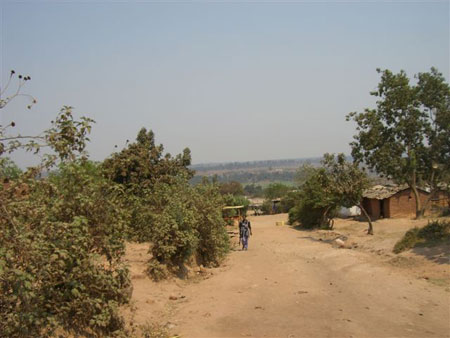
The road into Kantolomba
I arrived without any particular notice. A few children shouted “Masungo!” (“white person!”) as I passed, but not so many. It is different now from the beginning of our work in Kantolomba, when few people there had ever seen white skin before. Then, we were like rock stars, swarmed every time we arrived by screaming children. As I got out of the truck I realized, with a warm feeling in my heart, that we have become a part of Kantolomba. We are not strangers any more. People know us, and the work we are doing: we belong here now.
Along the way we found Christopher and Pascal, the two carpenters we hired in July to install the new roofs that I mentioned yesterday. They have been joined by Evaristo (local genius, winner of the national science competition last year, whom people will remember from previous blogs), who is working for Living Compassion while the next stage of his career becomes clear to him. The three were hard at work roofing a house beside the road.

A newly roofed house

Christopher and Pascal
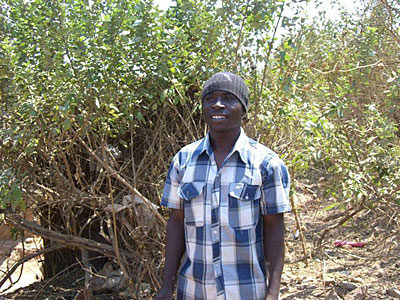
Evaristo
The house belongs to Anne, one of the Living Compassion women. She is one of 19 who have received loans from generous trustees in America. The loans are to put roofs on people’s houses so that they will survive the rainy season. This is one of the tragedies that happens here each year: the houses in the compound, most of them, are roofed only with flattened fifty-gallon drums and bits of plastic. About a third collapse during the rainy season each year, leaving the large families dwelling inside to shift as they may. The loans will be paid off bit by bit over the next couple of years. As the money returns it will be loaned out again, providing more families with the security of a strong and safe home.
Anne’s house is brand new. Her old house had a water line running right through her living room, so she decided to use part of her Living Compassion loan to tear down her existing house and rebuild it a few feet away, on the other side of the pipe.
While we admired the house and the work that was being done, Anne herself showed up, obviously amazed by what was happening, and grateful beyond expression. “This is my house! This is my house!” she kept saying.
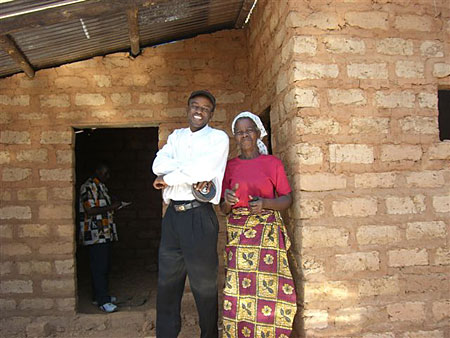
Friday and Anne in front of Anne’s house
After congratulating the workers on their progress, Friday and I pressed on to the Living Compassion property. We found Theresa there, who took me around to be welcomed by the other Living Compassion women. They were mostly engaged in cooking and cleaning up from feeding the children. They are feeding 350 now (can you believe it?) each day. The children come in shifts, between their classes, for their meal. This is one of those things you really have to see to believe. It is a monumental task every day to prepare so much food, especially as they cook over charcoal fires and must carry all the water from the nearby tap for cooking and clean-up. The children sit on reed mats on the floor, and eat their food with their hands (the local custom) off of colorful plastic plates. Theresa told me that the women went through sixty-five huge sacks of mealy-meal last month! It is a happy thing to think of so much food coming into the compound, and all the healthy bodies, young and old (for the women and the carpenters eat each day as well) that are benefiting from this work.
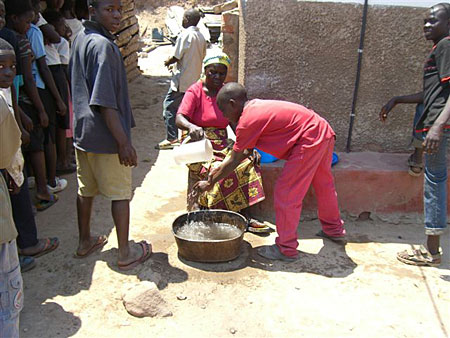
Handwashing before lunch

Regina and Veronica serving “nchima”

Lunchtime
Together, those of us in America and those in Kantolomba have created something wonderful. I knew this already before today, of course, but I understood it again this morning at a new level. It really is astounding to think that I will leave here next Tuesday to go back to my regular life, but the good that is being done here will not stop. These women will continue to show up day after day. They will go on living out an opportunity that was unthinkable a short time ago, and from that opportunity will go on giving back to their community in the way that they do. I looked over the property and all the people there, most of them children, some of them men and women from the compound come to draw clean water, and felt grateful for the inspiration that brought this place into being. At some point, hopefully, people will come for medical care and counseling as well. All of us who are involved know the same thing: it is good to be a part of this.
After half an hour or so spent in gawking at our project in this way, and in admiring the changes in our building and all the improvements around the property, I finally went to work.
Our first task was to meet with Francis, a local electrician. Three of the houses that have been roofed over the past month are on the Living Compassion property. They are occupied by three of the women who do the daily work, and their families. It occurred to us that it would not be too difficult to wire these houses, plus a fourth that is right next door, for electricity. Francis had come to explore this possibility with us.

Francis
Francis, Friday, Theresa, and I then toured the four houses to decide exactly how we wanted the work to be done (where the lights would be, how many outlets each house would have, etc.). As we did, I think it became clear to all of us what a huge deal it would be if these people suddenly got electricity. It is something they have only dreamed of until now. We realized that we have the power (in more ways than one) to make a miracle happen.
We left Francis to do his calculations and make a parts list, and then proceeded on to the next item on our agenda. Along the way we were surprised by Georgina, carrying baby David in her arms! “Come, David.” she said to him, “Meet your namesake.”
Baby David was born about four months ago. This was my first opportunity to meet him. “He looks just like you!” Georgina said when she gave him to me. I was nearly speechless with delight. We all sat down on some stones to spend some time with the little guy. What a handsome rascal he is! I told Georgina how honored I felt to share my name with her son, and how much it had moved me when I learned of it in July. I still cannot believe that this has happened. Holding Baby David in my arms, it was hard to forget (as it is sometimes easy to do) that I am one of those who are making a difference, also, just like the Living Compassion women, and that my own work has affected other people’s lives. Georgina smiled at me, as if she understood what I was thinking. “He will grow up to be big and strong like you,” she said.

Georgina and Baby David

Dave and Baby David
Soon it was time for Baby David’s next meal, and we took the opportunity to press on with our business. We went inside the “kitchen” building to visit with the four women (Georgina is one of them) who have spent the last six weeks on a gigantic sewing project. Soon after I return, Cheri will be attending an important conference and asked that 325 handbags be made for her to take with her to promote the project in Kantolomba. We went inside to find the women sitting in front of four sewing machines, surrounded by piles of scrap material and finished bags. The bags are terrific, I think. For some time we have been looking for a product we can market in the United States to help bring money to the compound, and I personally think the bags could be it. “How many do we have?” I asked them. They need to be finished by next Tuesday, as I will transport them home in my luggage. “Three hundred and two!” they replied. Only 23 more to go.
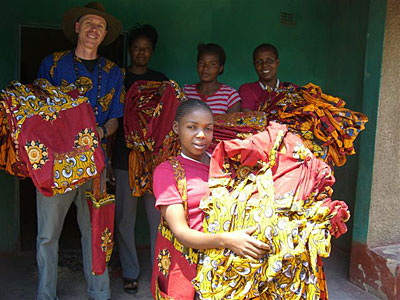
Dave, Nellie, Esther, Georgina, and Josephine (in front) with completed handbags
Next, Francis, Friday, and I piled into Friday’s truck for a dash to town to price the parts for the electrical project. We visited three shops, each one its own unique expression of African culture. I wish I had the leisure to describe in detail this short outing—every excursion like this is an adventure in itself around here—but, alas, I do not. We spent an hour zooming here and there, collecting our “quotations,” then returned just in time for a meeting with Gaudencia, the contractor responsible for the completion of our main building.
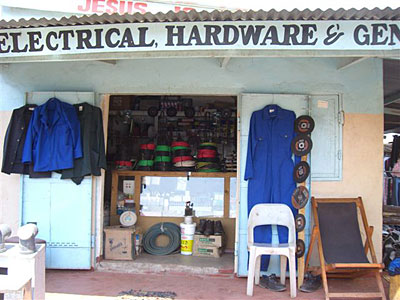
An electrical supply store
I enjoy and admire Gaudencia a great deal, and was tickled to see her. She was her usual strong and confident self. We had much to do, but before we got down to business I had the pleasure of delivering a gift to her from America. I had smuggled a power drill, some drill bits, and eleven pounds of screws into the country in my suitcase. These things cannot be obtained here in Ndola, and will greatly help her with the last phases of the building. Gaudencia was delighted, as you can imagine.
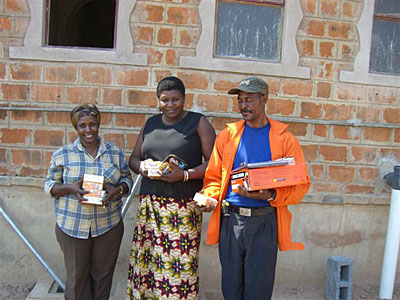
Gaudencia, Theresa, and James with their gifts
Then, as we have done so many times before, Theresa, Gaudencia, James (the foreman) and I walked through the building room by room to examine the work that has been done and to resolve any remaining issues. Much still remains to do, but nothing compared to what has been done already. The roof will hopefully be finished before I depart next week. This is an important point, as the rainy season begins in about a month. After the roof the ceiling will be installed, then the floor. At the same time the glass will be installed in the windows, the electrical wiring will be completed (it has mostly been done already), and the plumbing will be fine-tuned. Then there will be the painting (lavender, I’m told) and the clean-up, and we’re done! With a little luck all the children will use the new building for their schoolhouse this rainy season, and Jen and Cheri will find a finished project when they come here in January.
When we finished our walk-through, I was astounded to realize that it was late afternoon already. How time flies in Africa! There was nothing to do but return to the guesthouse for an evening meal and my computer, and to wait impatiently for the next day to come.
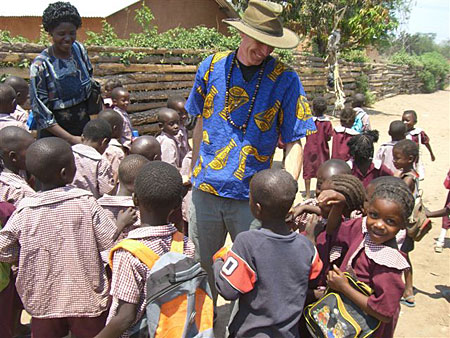
Dave saying goodbye for the day
